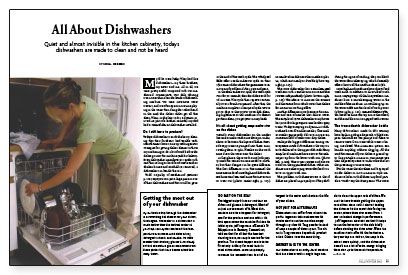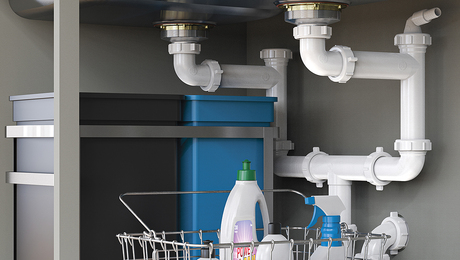All About Dishwashers
Quiet and almost invisible in the kitchen cabinetry, today's dishwashers are made to clean and not be heard.

Synopsis: What to look for when buying a new dishwasher, with a description of key features such as tub design, washer arms, filters, controls, and techniques manufacturers use to deaden sound. There are also a few tips on how to use a dishwasher effectively.
My folks were lucky: They had five dishwashers — my three brothers, my sister and me. All in all, we were pretty awful compared with our mechanical counterparts. Our daily whining was noisier than even the loudest dishwashing machine. We were notorious water wasters, and we often spent more time playing in the water than doing the task at hand. In the end, the dishes didn’t get all that clean. Then, in the late 1960s, salvation arrived. As part of a kitchen remodel, my dad had a state-of-the-art dishwasher installed.
Do I still have to prerinse?
Today’s dishwashers can do the heavy cleaning that their forebears had trouble with. Manufacturers have come up with ingenious strategies for getting dishes cleaner without anyone having to do a lot of work before the dishes go into the machine. Every dishwasher manufacturer I spoke with said that as long as hard food waste such as chicken bones and nutshells is removed, a dishwasher can handle the rest.
Todd Copitzky of KitchenAid says you can put a large pizza in one of their dishwashers and that it will be gone at the end of the wash cycle. The Whirlpool folks offer a soak-and-scour cycle on their 1500 Series dishwashers that guarantees to remove any food from dishes, pots and pans.
In the soak-and-scour cycle, the wash cycle runs for 90 seconds; then the dishes soak for 16 minutes. The cycle then repeats continually over a four-hour period. After that, the machine completes a heavy-soil cycle. You’ve got 30 days to throw your worst dish-cleaning nightmares at this machine. If it doesn’t get them clean, you get your money back.
It’s all about getting soap and water on the dishes
Virtually every dishwasher on the market has one or more wash arms that spin under, above or between the layers of dishes. Heated soapy water is pumped into these arms, causing them to spin. Nozzles on the wash arms direct the water onto the dishes.
At first glance, these wash arms look pretty much the same from one model to another, but their designs can be quite different. The first difference is in the material the arms are made of. Most high-end dishwashers have stainless-steel arms that never rust or wear out. Lower-level models use other metals or plastic, which isn’t nearly as durable.
The DCS dishwasher has a stainless-steel wash arm with a smaller arm on its end that rotates independently. The idea is to increase the sources and directions from which water hits dishes for maximum washing effect.
Another difference in wash arms is the number and size of nozzles that deliver water. The entry-level 1970s dishwasher at my house has just a few large square nozzles that spray water. Today’s Maytag and Jenn-Air dishwashers boast 60 smaller nozzles, The smaller nozzles supposedly deliver a more even, consistent flow of water over dirty dishes.
For more photos and details, click the View PDF button below:
Fine Homebuilding Recommended Products
Fine Homebuilding receives a commission for items purchased through links on this site, including Amazon Associates and other affiliate advertising programs.

A House Needs to Breathe...Or Does It?: An Introduction to Building Science

Not So Big House

Code Check 10th Edition: An Illustrated Guide to Building a Safe House


























